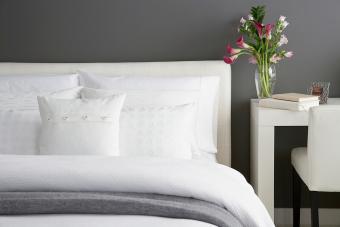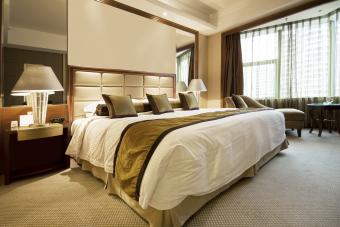
A list of bedding fabric types can help you decide which bedding best fits your needs. There are many choices that also include fiber blends.
Types of Cotton and Cotton Fabrics
There are many types of cotton used for bedding.
Cotton
Versatile, popular and inexpensive, cotton is a natural fiber that makes a good bedding choice for any style or age group.
- Use: Cotton bedding can be used for any bedroom style.
- Pros: Cotton is soft, comfortable, breathable and has a smooth finish. It accepts dyes easily and is used in fabric blends, such as polyester, linen and bamboo.
- Cons: Untreated, cotton will wrinkle.
Egyptian Cotton
Grown in the Nile Valley, Egyptian cotton is highly prized for its strong staple (fiber). Egyptian cotton is often over an inch long and has a luster. The cotton fabric woven from Egyptian cotton is typically soft.
- Use: This is a good choice for many master bedrooms with high-style décors.
- Pros: Egyptian cotton gives a nice finish and is considered a luxury item.
- Cons: Egyptian cotton usually costs more than most kinds of cotton.
Pima and Supima Cotton

The namesake for the Native American Pima tribe, Pima cotton is grown mostly in the southwestern region of the United States and Peru. This fiber (staple) is 1.5" long. It is sold as Pima cotton bedding and also under the brand Supima® cotton promoted by the Supima Association.
- Use: It's a great bedding choice for any bedroom style.
- Pros: Pima cotton is durable, soft and easy to dye.
- Cons: This cotton is more expensive than regular cottons, such as percale.
Percale
This fabric is breathable and made from 100 percent regular cotton and features a smooth matte crisp finish. A typical thread count is 350 to 400 TC, with others available as low as 180 TC.
- Use: It's an ideal choice for anyone needing bedding with a cooling property. Percale sheets can be used in any bedroom.
- Pros: The weave and thread count are ideal for soft sheets. Percale fabrics take dyes really well, affording colorful patterns and prints. It's inexpensive and affordable.
- Cons: Percale doesn't have the prestige of Egyptian or Prima cotton.
Jersey Knit
Another 100 percent cotton fabric, jersey knit, is referred to the T-shirt fabric.
- Use: This is a causal form of bedding that's often used for kids' and teens' bedrooms.
- Pros: The bedding is soft and comfortable.
- Cons: It's not as soft as percale. Jersey knits can be too warm for summer. Some jersey sheets stretch, resulting in fitted sheets being loose.
Flannel
Flannel sheets are made from 100 percent cotton woven looser than other cotton fabrics. It has a softly napped surface.
- Use: Flannel sheets are a great choice for winter bedding for any age group.
- Pros: Most flannel fabrics have a brushed finish for added softness. They are warm in winter and heavier than jersey knit.
- Cons: Flannel is too warm for most summer climates.
Sateen
This cotton weave has a soft finish that is lustrous and similar to satin. This is a good choice between cotton and satin.
- Use: This bedding choice is good for the master and guest bedrooms.
- Pros: Sateen fabrics are softer than percale and have a silk-like sheen.
- Con: Sateen doesn't have the crispness of percale.
Organic Cotton
This cotton is grown using organic farming techniques and principles that exclude pesticides, man-made synthetic fertilizers and harmful chemicals/dyes.
- Use: This bedding fabric is ideal for any bedroom or age. It's a great choice for someone with allergies.
- Pros: Organic cotton is an eco-friendly fiber and an excellent choice for anyone sensitive to chemicals. Organic cotton growing preserves ecosystems.
- Cons: Check labeling since some organic fabrics are processed using chemicals. This cotton can be more expensive than other cotton bedding.
Linen
Linen is the product of the flax plant, specifically the cellulose fibers found in the flax plant stalks. Cotton and linen are often blended for a very breathable fabric.
- Use: This is a good choice for any bedroom, especially if you want bedding that's a little warmer for cooler months than cotton sheets, but not as heavy as flannel.
- Pros: Linen sheets have a wicking property that keeps you cool and comfortable. It is a good choice for cold weather use.
- Con: Some linen weaves can trap heat, making this bedding uncomfortable for hot summer climates. You cannot use harsh detergents with this fabric. Linen wrinkles very easily. The color choices are limited by the fiber's ability to take dyes.
Polyester
The production of polyester is possible thanks to oil, and the polymers created from it. This is a purely man-made fiber. The fabric has a soft finish.
- Use: You can use this bedding choice in any bedroom. If you're wanting vivid colors or bold patterns, this fabric can provide great choices.
- Pros: Polyester doesn't wrinkle so your sheets are always neat. It is a very durable fiber, inexpensive and is colorfast. This bedding fabric is inexpensive compared to others, such as Egyptian cotton or silk.
- Cons: Polyester doesn't breathe and can be trap heat, becoming too warm for comfort in the summer months. This fabric holds stains that aren't easy to remove. The fabric surface is prone to pilling.
Microfiber
This bedding fabric is a combination of polyester and nylon.
- Use: This bedding is used for any bedroom style or age group.
- Pros: Microfiber is inexpensive, retains color and is water and stain repellent.
- Cons: The fiber can pill after multiple washings. The fabric has no breathability and it retains body heat.
Satin

Satin fabric has a luxurious feel and a silky sheen. It is made from a mixture of silk, polyester or nylon fibers. Most satins have a glossy top side, but the back side is dull.
- Use: This bedding is usually purchased for master bedrooms, offering a highly romantic and tactile bedding choice.
- Pros: Satin is very soft, comfortable, easily dyed for deep rich colors and doesn't trap heat.
- Cons: This fabric isn't usually warm enough for winter season use. Some people find satin sheets to be slippery.
Silk
100 percent silk is a luxury bedding choice. Silk is an ancient fabric made from silkworms. It is one of the most expensive types of bedding you can purchase.
- Use: Silk is mostly purchased for master bedrooms.
- Pros: It's lightweight and very comfortable. It has a wicking property and is ideal for anyone who runs hot. Silk is hypoallergenic and repels dust mites. Some people find silk too slippery for comfortable sleeping.
- Cons: Silk will stain easily. You can't use harsh detergents. A hangnail or ring can snag the fabric and create a run.
Bamboo
Bamboo bedding is an alternative to cotton and other fabrics. Choose organic bedding to take advantage of all the benefits bamboo has to offer. This is a renewable and highly sustainable fiber choice.
- Use: Bamboo bedding can be used in any bedroom style or age group.
- Pros: Bamboo is soft, comfortable, hypoallergenic, durable and breathable. It can be used in all seasons.
- Cons: Not all bamboo is organic or processed using organic manufacturing practices. Bamboo is more expensive than percale, microfiber and other bedding.
List of Bedding Fabric Choices
When you take time to compare the pros and cons for each bedding type, you can eliminate specific fabrics from your browsing list. Decide which fabric property is your highest priority and start shopping for your ideal bedding choice.
Bedding Fabrics and Thread Count
Many people focus only on thread count (TC) not taking into consideration the type of fiber used to weave the fabric. If a sheet thread count is high, such as 1200, the sheet threads may be two- or three-ply. This means two or three fibers are twisted together to form a single thread. More than one ply thread will also increase the size of the thread. When multiple ply threads are woven into a high thread count sheet, they can produce stiffer sheets.







